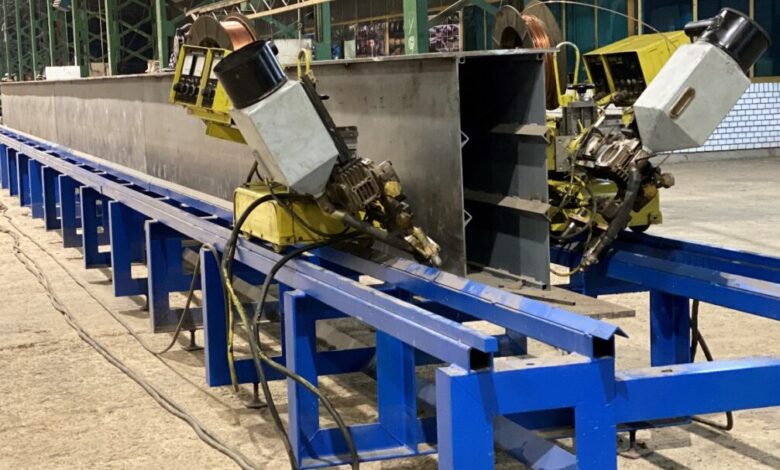H Beam Welding Machine | H Beam Production Line & Weld Solutions

Introduction to H Beam Welding
An H Beam, or universal beam, says H Beam horizontally, is a component of structural steel. Construction, infrastructure, and industrial tools utilize H Beams because they can withstand high vertical pressures while maintaining a high strength-to-weight ratio and stability while horizontally supporting covers integrated with the beam. H Beams have greater load-bearing flanges and also greater structural stability.
For more in-depth information, you should view the Top H Beam Production Line Manufacturer in China – Zhouxiang
Overview of H Beam Welding Machines
H Beam welding machines automate the H Beam welding and assembling process, making it easier to align, properly weld, and finish each piece with minimal human supervision. Full automation of the process is maintained with the addition of a toggling arm to perform repetitive movements and a hydraulic system to lift and position heavy parts. Labor costs and material debts due to waste can be minimized with their selective and accurate welding features.
View Top H Beam Production Line Manufacturer in China-Zhouxiang details to get into the details.
Significance of Welding in H Beam Production
In H Beam production, the process of joining various elements using Welding is of great importance as it integrates the various components of H Beam’s construction of joining the flanges, webs, and other components. The construction of H Beams requires structural strength and thus, properly executed welding facilitates their structural applications. The construction of H Beams incorporates varying degrees of structural welding and the strength and safety of the H Beams during their various end-use relies greatly on the quality of the welding construction. The quality of welding construction incorporated relies on the extent of automation in construction techniques. Automated construction execution techniques, as opposed to construction via pneumatic tools, focus on precision and reduce the occurrence of defects. They also reduce the time allocated to manual construction. These aspects are of great significance to the execution of large construction projects as they automate the techniques to the extent that the set construction deadline will not be compromised.
Understanding H Beam Production Line
Components of an H Beam Production Line
There are several crucial components within a production line aimed at manufacturing H Beams, and these components work together in a cohesive manner to maximize production efficiency and maintain manufacturing precision. These components typically are:
Feeding System: Loads and positions the raw material for processing on the production line.
Edge Milling Machine: Prepares the edges of steel plates to streamline the welding process.
Assembly Machine: Aligns the flange and web plates, assembling them to create the H Beam’s preliminary shape.
Welding Machines: Perform the welding of the web and flange plates, fastening them together.
Straightening Machine: Removes any structural deflection the welded beam may have, confirming the beam is straight and aligned.
Conveyor System: Moves materials and parts without obstruction during the production line.
Cutting and Finishing Equipment: Cuts the beam to specified dimensions and applies finishing as required.
Types of H Beam Welding Machines
Different welding machines are used for H Beam production because each machine is designed to fit various production needs and different welding methods:
Submerged Arc Welding (SAW) Machines: These are the most common because they create high-quality welds with great penetration and low imperfection levels.
Gas Metal Arc Welding (GMAW) Machines: Most popular due to their rapidity and versatility, particularly in automated settings.
Fillet Welding Machines: Tailored specifically for welding the fillet joints of H beams.
Tandem Welding Machines: Employ several welding heads to enhance productivity and minimize manufacturing duration.
H Beams Production Welding Operations
The H Beams production welding operations are performed in several sequential steps.
Material Preparation: For the web and flange plates, preparation demands clean edges and proper dimension to ensure fit.
Assembly and Tack Welding: The plates are put H-shaped and then tack welded to secure them in position.
Main Welding: For the primary welds, automated welding machines (saw, tandem) are used to accomplish it with extreme precision. The machines provide uniformity and ensure no defect occurs.
Cooling and Inspection: Once the welds are done, the beam rests and cools, then the welds are finally assessed for flaws.
Straightening: The distortions from the welding heat are corrected with the help of straightening machines.
Finishing and Quality Control: Quality control and industry standard verification completes the beam, following finishing procedures (cutting, grinding, etc.).
The integration of these advanced processes and technologies guarantees that the H Beam manufacturing lines produce accurately constructed beams that meet the specifications for diverse structural applications.
Welding Automation in H Beam Production
Advantages of Automation in Welding
Automation of welding processes brings numerous benefits, especially when it comes to producing H Beams. Automation welding systems allow producers to achieve uniform welding quality, thereby minimizing the chances of defects and rework. Automation also increases efficiencies in the production process and in the throughput of welding activities where human labor is involved. This also translates to cost benefits over the long run. Moreover, automation systems work to improve safety in the workplace by protecting human workers from extreme hot work environments and hazardous atmospheres. This range of benefits speaks to the dependability of automation systems in varying production requirements.
Dependable H Beam Welding Technology
In applications where H Beams are used, it is important to make sure a dependable welding solution is in place to uphold the structure. Robotic welding arms and programmable logic controllers are examples of newer technology that add value in the form of versatility, precision in work, and the range of quality welding activities a system can perform under varying working conditions and complex joint configurations. This is critical in meeting the production standards in the industry. Furthermore, dependable H Beam welding technology provides predictable performance in high production environments that is cost-effective in maintenance and reductions in system downtime.
Future Trends in Welding Automation
The advancements in H Beam production welding automation anticipate technologies that are smarter and more adaptable. Technologies such as artificial intelligence (AI) and machine learning will optimize various welding processes by analyzing relevant data and making real-time adjustments to enhance efficiency and quality. The use of collaborative robots, or ‘cobots,’ creates the opportunity for automation to integrate safely and flexibly in production environments, working in close proximity to human operators. Process control will be more precise with real-time monitoring, and the integration of environmentally friendly welding materials and techniques will become even more pertinent. The anticipated innovations described are the result of the evolution of welding automation systems, and their deployment will enhance efficiency, precision, and eco-friendliness.
Applications of H Beams in Various Industries
H Beams in the Construction of Wind Towers
H Beams are fundamental in the construction of wind towers. The massive installations are of considerable height; therefore, the H Beams must also be of considerable height, so they can bear the considerable weight. The remarkable H Beams must also be able to withstand considerable wind and mechanical stresses. Their precise and consistent manufacture also aids the wind energy establishments to endure and last longer.
H Beams in Construction and Infrastructure
The versatility of H Beams makes them invaluable within the construction and infrastructure industries. They can be relied upon to support the construction of buildings, bridges, and large structures, which are all able to carry considerable weight. H Beams are optimally designed to carry considerable weight and large structural spans while minimizing the volume of construction material, thus, economically and environmentally benefitting modern construction.
H Beam in Industrial Applications
H beams are utilized widely in various industrial applications because of their strength and rigidity. They range from heavy machinery support structures to key components of large industrial buildings. H Beams guarantee operational safety and efficiency. An H beam’s flexible use in different surroundings and capacity to withstand extreme temperatures and climatic conditions in manufacturing, energy, and warehousing continue to make H Beams indispensable.




